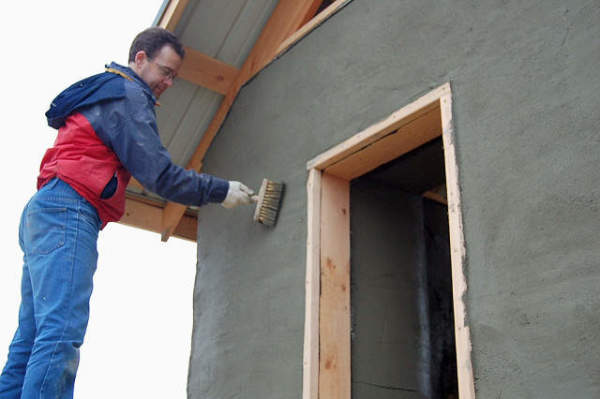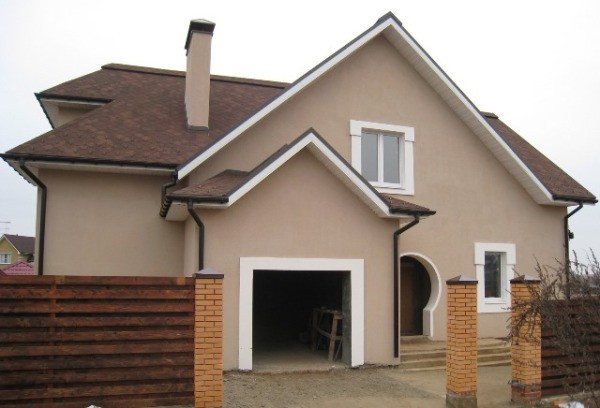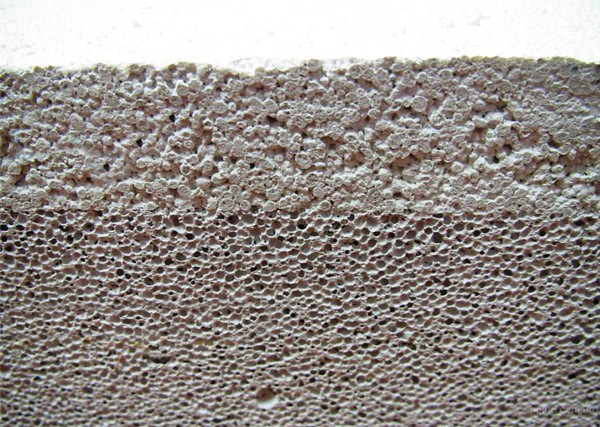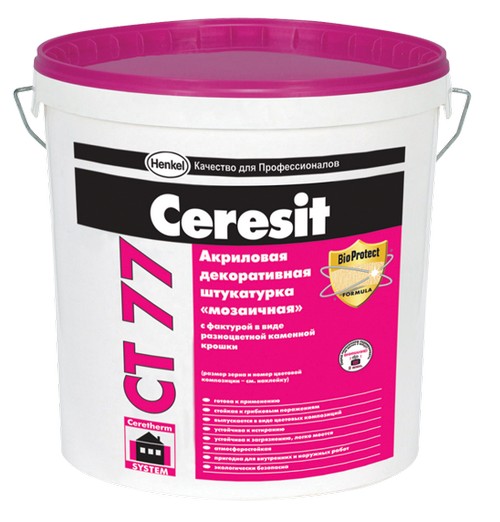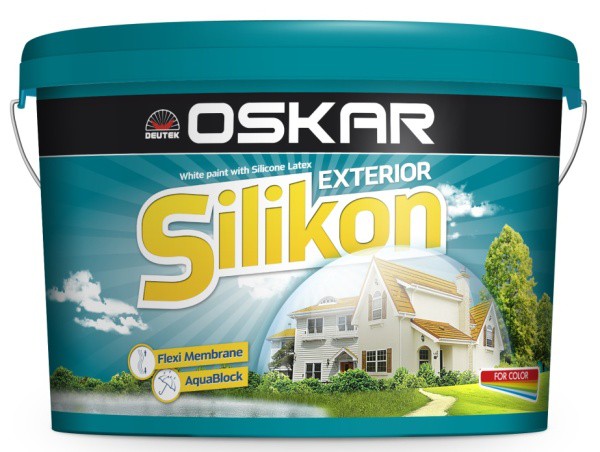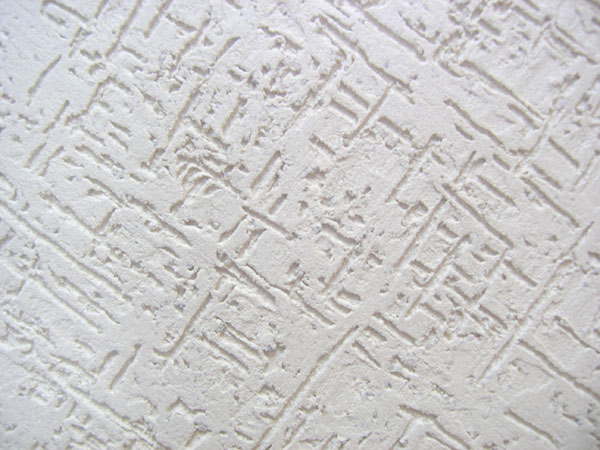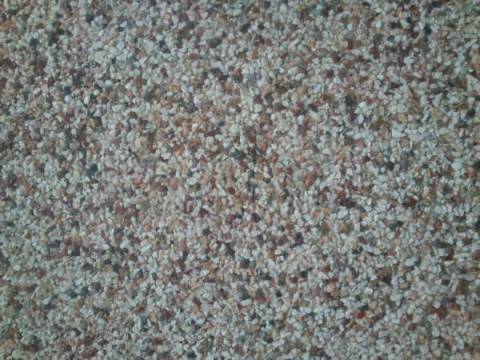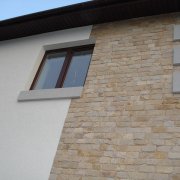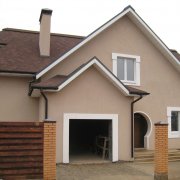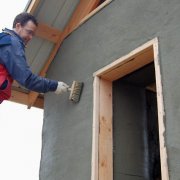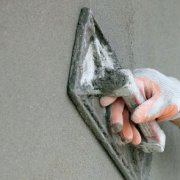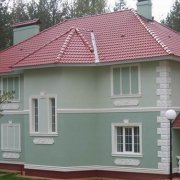Stucco of the facade of the house, as a way of decorating it and extending the service life
Among the many ways of exterior decoration, decorative stucco of the facade of the house is considered one of the most common. Without requiring excessive financial costs, it allows you to insulate the structure, increase its sound insulation, protects the wall material from moisture, fire, freezing and other negative factors. And at the same time it also gives it an aesthetic appearance.
The content of the article
Advantages of facade plaster
This practical option is chosen for the fact that it has many advantages, including:
- Easy to do with your own hands. Possessing theoretical knowledge and having the opportunity to observe the work of the masters, you will be able to plaster your house yourself outside.
- Mechanical strength. A well-made coating resists impacts, scratches and other mechanical stresses well.
- Resistance to temperature. The stucco facades of houses do not respond to frost and summer heat, to sudden changes in temperature, do not burn and do not melt.
- Moisture resistant. High humidity, rain and melting snow do not significantly affect the coating, do not penetrate into it.
- Sound and heat insulation properties. These parameters depend on the thickness of the plaster and increase with it.
- Vapor permeability. The ability to pass air and water vapor has a positive effect on the internal microclimate of the house, supporting its natural ventilation.
- Acceptable price. This type of exterior decoration belongs to the middle price category and is affordable for most private developers.
- A variety of design solutions. A wide range of plaster compositions allows you to choose the texture and color of the finished coating.
However, quite often the owners of plastered houses complain that the newly finished surface is covered with cracks, stains, swells, exfoliates or crumbles. This can happen for a variety of reasons.
For example, due to poor preparation of the base, its incompatibility with the selected composition or as a result of using cheap, expired, low-quality plaster. Therefore, the finishing process must be approached responsibly at each of its stages, starting with the choice of material.
Choosing plaster for the facade
Exterior plastering is exclusively done. facade plasterswith special resistance to weathering. They are different and are classified according to such signs as: composition, purpose, method of application.
Appointment
According to the purpose of the plaster are divided into:
- Standard - are used to protect the wall material from damage, sealing joints and cracks, leveling the bases for subsequent finishing;
- Special heat-insulating - create an additional outer layer that prevents the penetration of cold inside the house;
- Decorative - used as a topcoat for decorating facades.
Note. Decorative plaster on the facade of the house is able to perform several functions - aesthetic, protective, insulating.
Structure
Depending on which substance is a binder in the composition of plaster mixtures, they are divided into four main types:
- Cement based mineral plaster (see Which plaster is better - gypsum or cement: characteristics of building mixtures) The most common and inexpensive. Its advantages include strength, immunity to fungi and mold, resistance to moisture. The disadvantages are the lack of decorativeness. This is a white or gray, dry, powdery mixture, which is diluted with water in the proportions specified by the manufacturer before use. Such plastering of house facades is performed to level them and create a base for painting.
- Synthetic resin based acrylic plaster. Generally used as decorative finishes, creating a frost-resistant, durable, vapor-permeable and waterproof coating. Very plastic, easy to apply.
Note. Acrylic compounds are delivered ready-made in buckets of different capacities. They can be of any color, contain solid inclusions that form a texture, and can also be tinted by the introduction of pigments.
- Silicate plaster based on liquid potassium glass. It has high strength, ductility and resistance to moisture. Special advantages include increased vapor permeability and antistatic properties, the ability to repel pollution, due to which the surface always maintains a neat appearance.
- Silicone plaster based on polymer binders. The most expensive of these, but also the highest quality, as it combines all their advantages: resistance to any external influences, strength, durability, excellent decorative characteristics, compatibility with any base. In addition, this material is perfectly tinted, which allows you to choose any desired shade from a rich color palette.
Application Method
The thickness of the plaster layer and the texture of the finished surface depend on the application method. The solution can be dispensed and evened out manually, or it is possible to partially automate the process using special machines with which the spray is carried out.
More about this method, about how to plaster the house outside (see Exterior decoration of the house with plaster: choose the option) - video on this page. But the texture depends both on the application method and on the content of solid fillers in the mixture, their size and origin.
So:
- Bark beetle, lamb (see Plaster front Lamb - a practical "clothing" for your home) Is a plaster with insoluble mineral granules that, during the grouting of the mortar deposited on the walls, move along the surface, leaving characteristic traces on it that resemble the curls of a sheep fleece or the moves of a wood-beetle beetle. The relief and expressiveness of the texture depend on the size of the granules.
- Pebbled plaster also contains a large amount of coarse mineral filler. During grouting, the stones are laid in a continuous layer and, after drying and shrinkage of the solution, protrude above the surface in the form of a chaotic relief.
- Mosaic decorative plastering of house facades refers to finishing materials that do not require subsequent painting. As a filler, it uses small colored stones and pieces of resin, which create an original decorative coating.
There are other types of textured decorative plaster, but they are quite complicated for self-application.
Rules for plastering facades
As you may have noticed, the choice of materials for the decoration of facades is quite large. But, despite this diversity, the application technology for the different compositions is the same.
Plastering the house outside with your own hands consists of the following steps:
- Arrangement of scaffolding necessary for safe and high-quality work at height;
- Cleaning the facades of the old coating, excess mortar in the joints of masonry, dirt, dust, etc .;
Note. If the base is a layer of old stucco that adheres firmly to the walls, you do not need to remove it. It is necessary to cut furrows in it for better adhesion with a subsequent new layer.
- Processing the cleaned base with a primer appropriate to the material of the walls;
- If the surface to be trimmed is too smooth or has poor adhesion to the mortar, a special reinforcing mesh for plastering the facades of houses is mounted on it;
- Preparation of the solution according to the manufacturer's instructions. The volume of the batch depends on the performance of the master (machine) and the pot life of the stucco mixture;
- Application As mentioned above, it can be performed manually or mechanically;
- Leveling. Without dwelling on in detail at this stage, we can only say that leveling and stretching the plaster can be done with various tools and methods;
- Finishing - grouting, painting. It is made in accordance with the technology of finishing with the selected type of plaster.
This is a very brief description of the process. In more detail, the technology of plastering facades is discussed in other materials of the site.
Conclusion
The advent of new modern materials has greatly changed the attitude towards plaster. It no longer appears to be a layer of rough gray mass on the walls of buildings. It is enough to watch the video in this article to make you want to make your home beautiful, durable and protected from the weather with the help of this decorative material.
